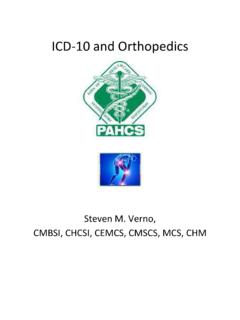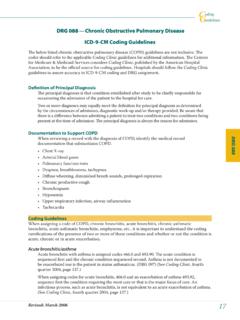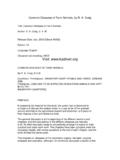Transcription of ICD-10-CM and PODIATRY - PAHCS
1 ICD-10-CM and PODIATRY Steven M. Verno, CMBSI, CHCSI, CEMCS, CMSCS, MCS, CHM ICD-10 and PODIATRY Steven M. Verno, CMBSI, CHCSI, CEMCS, CMSCS, MCS, CHM April 8, 2015 The information in this guide came from ICD-10 sources available for free on the internet at the CMS or World Health Organization website. Note: ICD-9-CM and ICD-10 are owned and copyrighted by the World Health Organization. The codes in this guide were obtained from the US Department of Health and Human Services, NCHS website. This guide does NOT discuss ICD-10-PCS. This guide does NOT replace ICD-10-CM coding manuals or is to be used as a cheat sheet for coding. This guide simply shows a practice what ICD-10-CM will look like within their specialty, so that the practice can see that ICD-10 is NOT scary or overly complex.
2 The intent is to show that ICD-10 is not scary and it is not complicated This guide is NOT the final answer to coding issues experienced in a medical practice. This guide does NOT replace proper coding training required by a medical coder and a medical practice. Images or graphics were obtained from free public domain internet websites and may hold copyright privileges by the owner. Coding Guidelines Many of the guidelines under ICD-9-CM wont change under ICD-10-CM . You will see new guidelines because ICD-10 will offer new codes never seen before. As an example of guidelines that will look familiar to you: ICD-9 Guideline for Symptoms: Signs and symptoms Codes that describe symptoms and signs, as opposed to diagnoses, are acceptable for reporting purposes when a related definitive diagnosis has not been established (confirmed) by the physician.
3 Chapter 16 of ICD-9-CM, Symptoms, Signs, and Ill-defined conditions (codes ) contain many, but not all codes for symptoms. 7. Conditions that are an integral part of a disease process Signs and symptoms that are integral to the disease process should not be assigned as additional codes. 8. Conditions that are not an integral part of a disease process Additional signs and symptoms that may not be associated routinely with a disease process should be coded when present. ICD-10 Guideline for Symptoms: Signs and symptoms Codes that describe symptoms and signs, as opposed to diagnoses, are acceptable for reporting purposes when a related definitive diagnosis has not been established (confirmed) by the provider.
4 Chapter 18 of ICD-10-CM , Symptoms, Signs, and Abnormal Clinical and Laboratory Findings, Not Elsewhere Classified (codes - R99) contains many, but not all codes for symptoms. 5. Conditions that are an integral part of a disease process Signs and symptoms that are associated routinely with a disease process should not be assigned as additional codes, unless otherwise instructed by the classification. 6. Conditions that are not an integral part of a disease process Additional signs and symptoms that may not be associated routinely with a disease process should be coded when present. As you can see, both guidelines are virtually identical, so the change to ICD-10 wont be a shock to a trained coder. Coding Guidelines for PODIATRY The following are some ICD-10 coding guidelines that may impact PODIATRY providers.
5 Please note that these are not ALL of the ICD-10 guidelines, just a sample, and, again, these look identical to ICD-9 guidelines. These guidelines are published by the World Health Organization: Signs and symptoms Codes that describe symptoms and signs, as opposed to diagnoses, are acceptable for reporting purposes when a related definitive diagnosis has not been established (confirmed) by the provider. Chapter 18 of ICD-10-CM , Symptoms, Signs, and Abnormal Clinical and Laboratory Findings, Not Elsewhere Classified (codes - R99) contains many, but not all codes for symptoms. Conditions that are an integral part of a disease process Signs and symptoms that are associated routinely with a disease process should not be assigned as additional codes, unless otherwise instructed by the classification.
6 Conditions that are not an integral part of a disease process Additional signs and symptoms that may not be associated routinely with a disease process should be coded when present. Multiple coding for a single condition In addition to the etiology/manifestation convention that requires two codes to fully describe a single condition that affects multiple body systems, there are other single conditions that also require more than one code. Use additional code notes are found in the Tabular at codes that are not part of an etiology/manifestation pair where a secondary code is useful to fully describe a condition. The sequencing rule is the same as the etiology/manifestation pair, use additional code indicates that a secondary code should be added.
7 Code first notes are also under certain codes that are not specifically manifestation codes but may be due to an underlying cause. When there is a code first note and an underlying condition is present, the underlying condition should be sequenced first. Code, if applicable, any causal condition first , notes indicate that this code may be assigned as a principal diagnosis when the causal condition is unknown or not applicable. If a causal condition is known, then the code for that condition should be sequenced as the principal or first-listed diagnosis. Multiple codes may be needed for late effects, complication codes and obstetric codes to more fully describe a condition. See the specific guidelines for these conditions for further instruction.
8 acute and chronic Conditions If the same condition is described as both acute ( subacute ) and chronic , and separate subentries exist in the Alphabetic Index at the same indentation level, code both and sequence the acute ( subacute ) code first. Diseases of the Musculoskeletal System and Connective Tissue (M00-M99) a. Site and laterality Most of the codes have site and laterality designations. The site represents either the bone, joint or the muscle involved. For some conditions where more than one bone, joint or muscle is usually involved, such as osteoarthritis, there is a multiple sites code available. For categories where no multiple site code is provided and more than one bone, joint or muscle is involved, multiple codes should be used to indicate the different sites involved.
9 Bone versus joint For certain conditions, the bone may be affected at the upper or lower end, ( , avascular necrosis of bone, M87, Osteoporosis, M80, M81). Though the portion of the bone affected may be at the joint, the site designation will be the bone, not the joint. acute traumatic versus chronic or recurrent musculoskeletal conditions Many musculoskeletal conditions are a result of previous injury or trauma to a site, or are recurrent conditions. Bone, joint or muscle conditions that are the result of a healed injury are usually found in chapter 13. Recurrent bone, joint or muscle conditions are also usually found in chapter 13. Any current, acute injury should be coded to the appropriate injury code from chapter 19.
10 chronic or recurrent conditions should generally be coded with a code from chapter 13. If it is difficult to determine from the documentation in the record which code is best to describe a condition, query the provider. Osteoporosis Osteoporosis is a systemic condition, meaning that all bones of the musculoskeletal system are affected. Therefore, site is not a component of the codes under category M81, Osteoporosis without current pathological fracture. The site codes under category M80, Osteoporosis with current pathological fracture, identify the site of the fracture, not the osteoporosis. Osteoporosis without pathological fracture Category M81, Osteoporosis without current pathological fracture, is for use for patients with osteoporosis who do not currently have a pathologic fracture due to the osteoporosis, even if they have had a fracture in the past.













